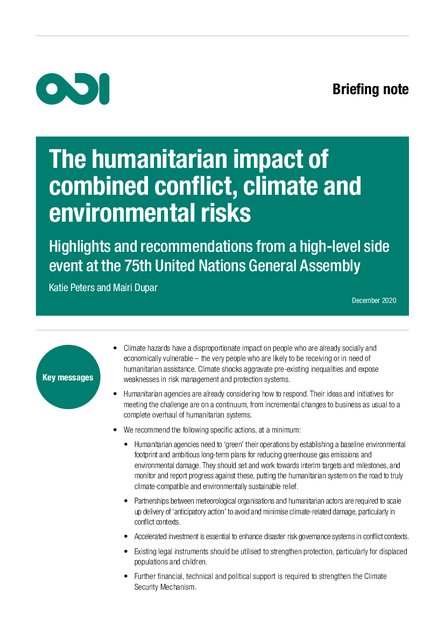
The intersection of conflict, climate change and environmental risk has been the subject of academic research for more than two decades. It has featured in reports from the Intergovernmental Panel on Climate Change and been the subject of a plethora of media articles. It has been hotly debated at the United Nations (UN) Security Council and scrutinised by the world’s largest military powers. However, little space has been dedicated to exploring the implications for the humanitarian sector.
The UN General Assembly (UNGA) ministerial event ‘The humanitarian impact of combined conflict, climate and environmental risks’ on 25 September 2020 marked an important step forward in focusing governments, donors and aid agencies’ attention on these intersecting risks (see Box 1). Summarised below are core themes from the UNGA75 event, with extracts from official statements submitted by government, UN and humanitarian agencies. It should be noted that multiple delegates voiced the ideas presented below but for brevity we have included only one citation to illustrate each point.
Key Messages:
- Climate hazards have a disproportionate impact on people who are already socially and economically vulnerable – the very people who are likely to be receiving or in need of humanitarian assistance. Climate shocks aggravate pre-existing inequalities and expose weaknesses in risk management and protection systems.
- Humanitarian agencies are already considering how to respond. Their ideas and initiatives for meeting the challenge are on a continuum, from incremental changes to business as usual to a complete overhaul of humanitarian systems.
- We recommend the following specific actions, at a minimum:
- Humanitarian agencies need to ‘green’ their operations by establishing a baseline environmental footprint and ambitious long-term plans for reducing greenhouse gas emissions and environmental damage. They should set and work towards interim targets and milestones, and monitor and report progress against these, putting the humanitarian system on the road to truly climate-compatible and environmentally sustainable relief.
- Partnerships between meteorological organisations and humanitarian actors are required to scale up delivery of ‘anticipatory action’ to avoid and minimise climate-related damage, particularly in conflict contexts.
- Accelerated investment is essential to enhance disaster risk governance systems in conflict contexts.
- Existing legal instruments should be utilised to strengthen protection, particularly for displaced populations and children.
- Further financial, technical and political support is required to strengthen the Climate Security Mechanism.